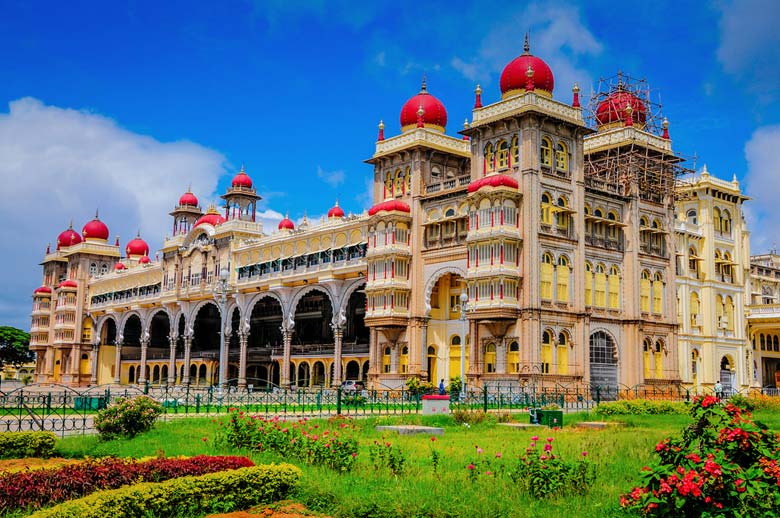Tourist Sightseeing Places in Bangalore
Located at 1,040 km (645 mi) southeast of Bombay, 140 km (87 mi) northeast of Mysore, 290 km (180 mi) west of Madras. ,Bangalore exudes a modernity that’s unmatched by any other Indian city. Relatively new—at the end of the 16th century there was nothing here but a mud fort and a small bull temple, both built by the founding chieftain Kempe Gowda—it’s also India’s most anglicized metropolis. The name-changing bug hasn’t touched most of Bangalore; Brigade Road, St. Marks Road, Fraser Town, Cubbon Road, and Queen’s Circle have all retained their names from the British days. Yet the city’s Janus-faced profile takes another form: There’s a clear divide between the Cantonment and the City areas, separated by Cubbon Park. The Cantonment is cosmopolitan, its yuppies leading a Western lifestyle, while the City is more conventional, guarding middle-class values and an old section once ruled by the princely state of Mysore. While M. G. Road and the adjacent Brigade Road constitute the center of the garrison, where old and quaint buildings lie near latter-day shopping malls, K. G. Road, also known as the Majestic area, near the train station forms the focus of the city belt, abounding in offices, shops, cinemas, hawkers, and travelers.
Also Visit – https://www.swantour.com/south-india-tours/bangalore-ooty-kodaikanal.php
Bangalore’s salubrious climate (which has earned it the sobriquet “Pensioners’ Paradise”) and green environs have attracted so many scientists, industrialists, academics, and defense personnel since the 1980s that Bangalore is now the fastest-growing city in India and the national center of telecommunications and information technology. This explosive boom has drawn multinational corporations (Oracle, Motorola, Sun Microsystems) and the combination of money and international influence has made the city increasingly snazzy, with such Western commercial elements as trendy boutiques and nearly 200 pubs, where beer is drunk with gusto (although local authorities have recently enforced an 11 P.N.4 closing time). Students, software engineers, and even families huddle in pubs, pizza parlors, and cyber kiosks and window-shop in splenc!'” malls. Yet effective urban planning—rare in India—has given the city a serene, orderly feel.
It’s hard to spend more than a day seeing Bangalore’s historic sights. You’ll have plenty of time left over to soak up the city’s fresh, con-temporary feel by browsing its shops, trying some of its excellent restaurants, and knocking back a beer or two in a pub.
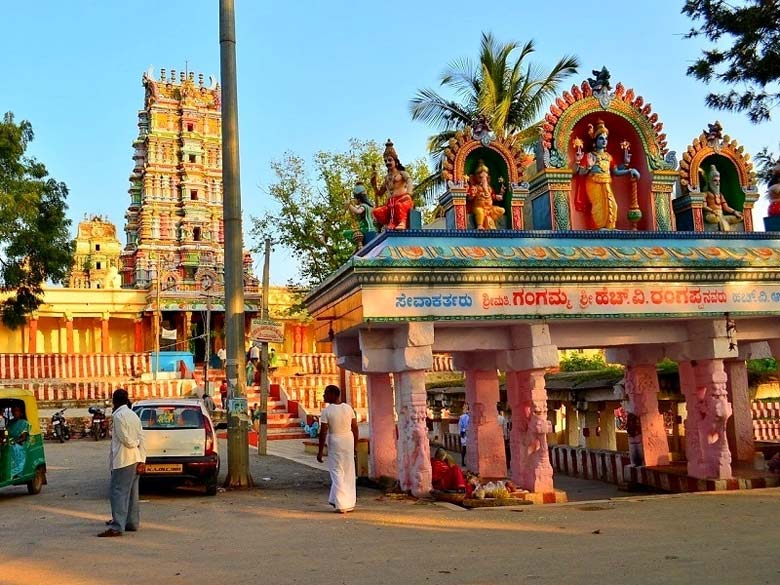
Bangalore Tourist Attractions
Bangalore’s heart is the area near Mahatma Gandhi, Brigade, and Residency roads. The bustling streets around the train station and Race Course Road are also well worth getting lost in for a couple of hours. For a good tour, start with a taxi to the Bull Temple. A 20-minute walk east on B. P. Wadia Road brings you to the tropical Lal Bagh Botanical Gardens. Head north through the gardens and come out on the Lal Bagh Fort Road side; turn left onto this road and continue to a large intersection. On your left is Krishnarajendra Road; on your right, Avenue Road. Turn onto Avenue Road, and shortly, on your left, where Avenue Road is intersected by Albert Victor Road, you’ll come to Tipu’s Palace.
Outside the palace, the urban scenery is rather dull, so you might decide to cheat and take an auto-rickshaw. If you do, stop at Mysore Bank Circle and walk down K. G. Road for 10 minutes to get a feel for this crowded area. Alternately, follow the narrow, busy Avenue Road for about 2 km (1 mi) to reach Mysore Bank Circle and K. G. Road. From some point on K. G. Road, take an auto-rickshaw to Vidhana Soudha, on Dr. Ambedkar Veedi Road, the spectacular building that houses the state legislature. To your right is the red-brick High Court of Karnataka. Continue up Dr. Ambedkar Veedi Road until you come to Cubbon Road (here, again, the scenery is insignificant, so you may want to cut to an auto-rickshaw). From Minsk Square you can walk left along Cubbon Road or straight toward Queen’s Circle, with the cricket stadium on your left and Cubbon Park on your right. From either one, return to Queen’s Circle, where M. G. Road starts.
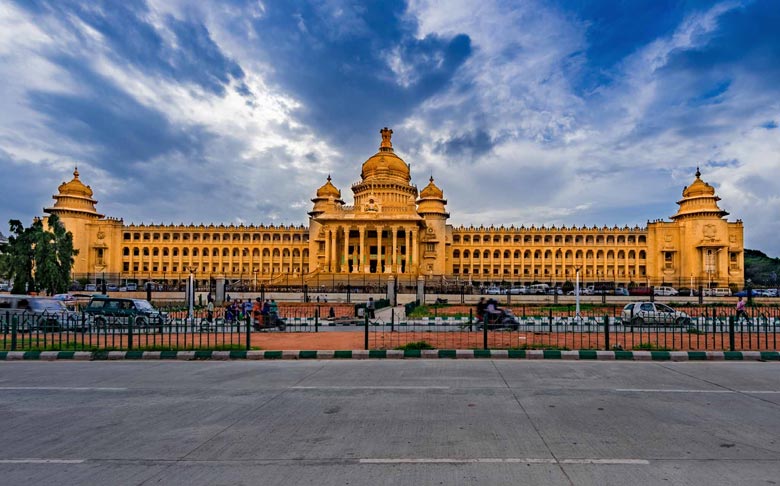
Bangalore Tourist Places
By now you may need refreshment. Head across M. G. Road to Brigade Road and you’ll see the Cyber Cafe on your left. After putting up your feet for a bit, head back to M. G. Road: To your left and right are several ritzy shopping arcades and state-run crafts and silk emporiums. Wandering in and out of these can eat up a happy afternoon.
You’ll need the best part of a day for this walk; though taking auto-rickshaws on the plainer stretches can save a few hours. The Lal Bagh Gardens deserve at least an hour, Tipu’s Palace half an hour, and the Vidhana Soudha another half an hour. Shoppers will have a grand old time, but even diehards will probably want to call it a day after three hours. It’s best to set off fairly early in the morning, as the gardens are most pleasant then (and in the early evening).
List of Top 4 Sightseeing Places in Bengaluru
#1. Bull Temple
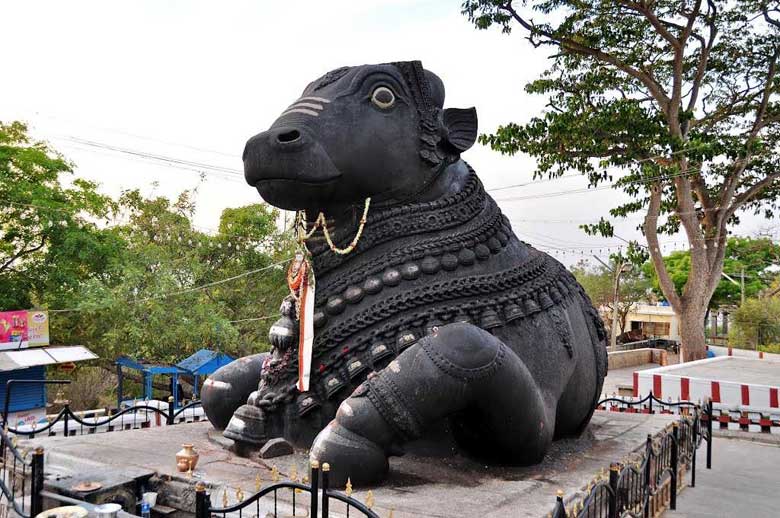
Bull Temple Bangalore
This small temple houses the enormous 1786 monolith of Nandi, the sacred Hindu bull, vehicle of Shiva. The temple’s front yard bustles with activity: Peddlers sell coconuts, bananas, and jasmine blossoms for offerings. Don’t be alarmed if a woman sitting on the pavement suddenly yanks out a live cobra from a straw basket in front of her, taunting it to fan out its collar: For a few rupees, you can snap a photo of the angry creature from as close (or as far) as you wish. In-side, Nandi lies in his traditional position, leaning slightly to one side with his legs tucked beneath him. The bull’s hefty black bulk is beautifully carved and ornamented with bells, and glistens with coconut oil that priests apply regularly to keep the stone moist.
#2. Lal Bagh Botanical Gardens
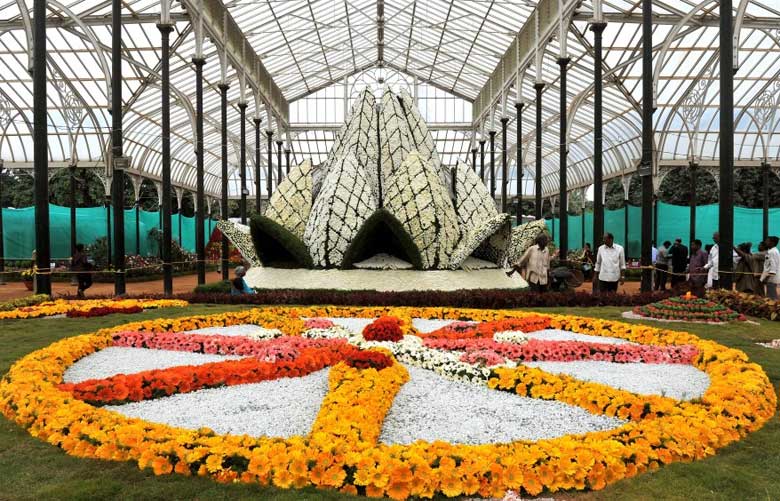
Lal Bagh Botanical Gardens Bangalore
This 240-acre park is one of the remaining reasons for Bangalore’s increasingly obscure nickname, “The Gar-den City.” Closed to auto traffic, the park is laced with pedestrian paths past more than 100 types of trees and thousands of varieties of plants and flowers from all over the world. Most of the flora is in their fullest bloom between October and December. Some trees, like the venerable 200-year-old elephant tree near the western gate entrance, date from the time of Tipu Sultan, who continued to develop the park in the late 18th century after the death of his father, Hyder Ali, who designed the grounds in 1760. Marking the heart of Lal Bagh is the Rose Garden, a square, fenced-in plot blooming with some 150 different kinds of roses. Just beyond, near the north gate entrance, is the Glass House, a cross-shaped pavilion built in 1881 with London’s Crystal Palace in mind. Twice a year, around Independence Day (August 15) and Republic Day (January 15), week-long flower shows are held here.
#3. Tipu’s Palace
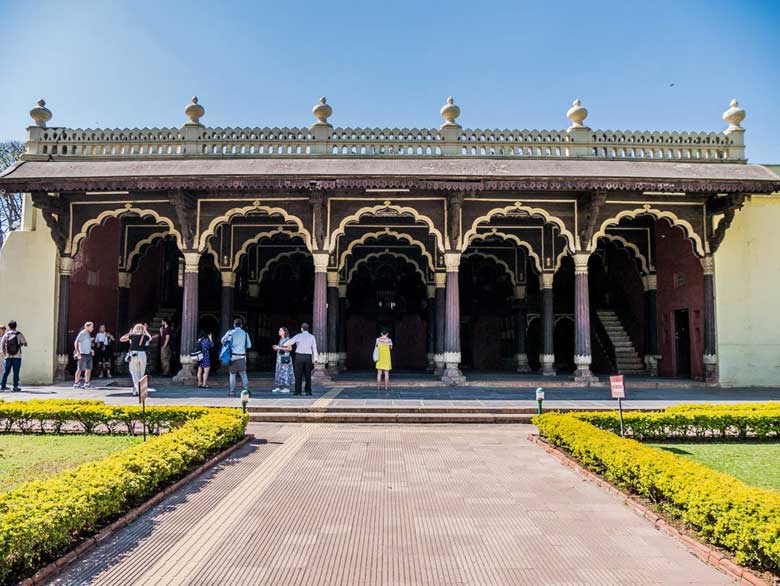
Tipu’s Palace Bangalore
Tipu Sultan built this palace for himself in 1789. Made of wood, it’s a replica of his summer palace on Srirangapatnam (a river island near Mysore), sans the elaborate fresco painting inside. The building now houses a modest photo exhibit about Tipu and his times.
#4. Vidhana Soudha

Bangalore Tourist Places
Bangalore’s most beautiful building is a relatively re-cent addition to the city, built between 1954 and 1958 to house the state legislature and secretariat. The sprawling granite structure was designed in the Indo-Dravidian style, studded with pillars and carved ledges and topped with a central dome that’s crowned, in turn, with a golden four-headed lion, emblem of the great 3rd-century BC Buddhist king Ashoka. The interior is not open to visitors. Facing the Vidhana Soudha head-on across the street is another of Bangalore’s attractive public buildings, the pillared, red-brick High Court of Karnataka, built in 1885 as the seat of the then-British government.
For more information on Tourist sightseeing places in Bangalore and other tourist spots in Karnataka, Contact Swan Tours, One of the leading Tour Operators in Delhi, India.
